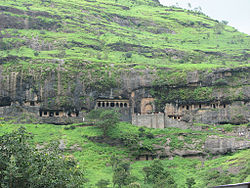| Lenyadri | |
|---|---|
 Lenyadri complex | |
| Location | Junnar, Maharashtra, India |
| Coordinates | 19°14′34″N 73°53′8″E / 19.24278°N 73.88556°E |
Lenyadri, sometimes called Ganesa Lena, Ganesh Pahar Caves, are a series of about 30 rock-cut Buddhist "caves", located about 4.8 kilometres (3.0 mi) north of Junnar in Pune district in the Indian state of Maharashtra. They are cut into a natural cliff or steep slope. Other caves surrounding the city of Junnar are: Manmodi Caves, Shivneri Caves and Tulja Caves. The Lenyadri caves date between the 1st and 3rd century AD and belong to the Hinayana Buddhism tradition.[1][2] Some have later been adapted to Hindu use.
Twenty-six of the caves are individually numbered. The caves face to the south and are numbered serially from east to west.[1][3][4] Caves 6 and 14 are chaitya-grihas (chapels), while the rest are viharas (dwellings for monks). The latter are in the form of dwellings and cells. There are also several rock-cut water cisterns; two of them have inscriptions. The layout of the caves, in general, are similar in pattern and shape. They generally have one or two sides with two long benches for occupants' use.[1][3][4]
Two of the central cells of Cave 7 – originally a Buddhist vihara – were at an unknown later date appropriated for the worship of the Hindu god Ganesha. The rest of the cells and the hall of Cave 7 remain in their original form.[5] This Ganesha Lena vihara is one of the Ashtavinayak shrines, a set of the eight prominent Ganesha shrines in Western Maharashtra. In regional mythology, this is the Girijatmaja cave where goddess Parvati desired to be a mother and where Ganesha was born.[6]
- ^ a b c Cite error: The named reference
asiwas invoked but never defined (see the help page). - ^ Feldhaus p. 143
- ^ a b Cite error: The named reference
Gazetteerwas invoked but never defined (see the help page). - ^ a b Cite error: The named reference
Edwardeswas invoked but never defined (see the help page). - ^ Vidya Dehejia (1969). "Early Buddhist Caves at Junnar". Artibus Asiae. 31 (2/3): 163–164. doi:10.2307/3249428. JSTOR 3249428.
- ^ John A. Grimes (1995), Ganapati: Song of the Self, State University of New York Press, ISBN 9780791424391, pp. 13-14
